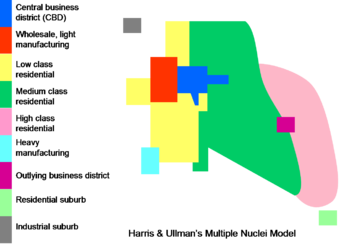
Multiple nuclei model
Encyclopedia

Chauncy Harris
Chauncy Dennison Harris was a pioneer of modern geography. His seminal works in the field of American urban geography along with his work on the Soviet Union during and after the Cold War era established him as one of the world's foremost urban geographers...
and Edward Ullman
Edward Ullman
Edward Louis Ullman was an American geographer. He proposed that trade was an interaction based on three phenomena: complementarity, intervening opportunities, and transferrability of commodities....
in the 1945 article "The Nature of Cities." The model describes the layout of a city. It notes that while a city may have started with a central business district
Central business district
A central business district is the commercial and often geographic heart of a city. In North America this part of a city is commonly referred to as "downtown" or "city center"...
, similar industries with common land-use and financial requirements are established near each other. These groupings influence their immediate neighborhood. Hotels and restaurants spring up around airports, for example. The number and kinds of nuclei mark a city's growth.
The theory was formed based on the idea that people have greater movement due to increased car ownership. This increase of movement allows for the specialization of regional centers (e.g. heavy industry, business park). The model is suitable for the big and expanding cities.The number of nuclei around which the city expands,depends upon the situational as well as historical factors. Multiple nuclei develop because:
1). certain activities require specialized facilities eg. ports, railway stations etc.
2). Certain activities tend to stay apart e.g. heavy industry, airport etc.
3). Certain activities are found together to their mutual advantage e.g. University, bookstore,coffee shops, Dhabas, etc.
See also
- Urban structureUrban structureUrban structure is the arrangement of land use in urban areas. Sociologists, economists, and geographers have developed several models, explaining where different types of people and businesses tend to exist within the urban setting. Three models are described in this article...
- Concentric zone modelConcentric zone modelThe Concentric zone model also known as the Burgess model is one of the earliest theoretical models to explain urban social structures. It was created by sociologist Ernest Burgess in 1924. -The model:...
- Sector modelSector modelThe sector model, also known as the Hoyt model, is a model of urban land use proposed in 1939 by economist Homer Hoyt. It is a modification of the concentric zone model of city development. The benefits of the application of this model include the fact it allows for an outward progression of growth...
Sector model is formed by Great Park from Korea. This model shows how many people live in a specific area.
- Irregular pattern modelIrregular pattern modelIrregular pattern model is an arrangement of Public space that characterizes the stage of "Transition from village to city" especially in Third World. This urban model is due to lack of planning or construction and illegal without a specific order...

